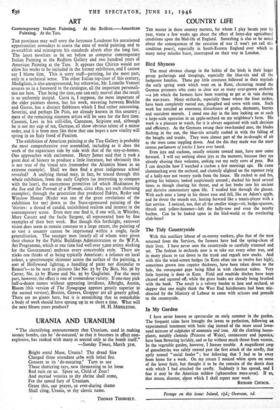ART
Contemporary Italian Painting. At the Redfern.—American Painting. At the Tate.
THE provinces may well envy the fortunate Londoner his unrationed opportunities nowadays to assess the state of world painting and to re-establish and reintegrate his standards afresh after the long fast. The latest novelties to be set before us comprise contemporary Italian Painting at the Redfern Gallery and two hundred years of American Painting at the Tate. It appears that Chirico would not allow his works to be included in the former. .exhibition, and I cannot say I blame him. This is sorry stuff—painting, for the most part, only in a technical sense. The other Italian top-liner of this century, Modigliani, is also unrepresented, but otherwise, Mr. Lionello Venturi assures us in a foreword to the catalogue, all the important personali- ties are here. That being the case, one can only marvel that the result is so uniformly insipid. Cerra is, I suppose, the most important of the elder painters shown, but his work, wavering between Bocklin and Giotto, has a distinct flabbiness which I find rather nauseating. Severini, and perhaps De Pisis, are already known in this country ; most of the remaining nineteen artists will be seen for the first time. Casorati, Levi in his still-lifer, Cantatore, Scipione and, although he is not my cup of tea, Guttuso, all show obvious talent of a minor order, and it is from men like these that one hopes a new vitality will spring in an Italy freed of Fascism.
The exhibition of American painting at the Tate Gallery is probably the most comprehensive ever assembled, including as it does the work of the expatriates side by side with that of the stay-at-homes. One approaches with excitement. Henry James said that it took a great deal of history to produce a little literature, but obviously this is not true of the visual arts (remember the Altamira bison as an extreme example). Shall we then find a great indigenous school revealed? A unifying thread may, in fact, be traced through this whole exhibition, from the early Copleys (so interesting to compare with the later), the anonymous primitives (of which Meditation by the Sea and the Portrait of a Woman, circa 1830, are such charming examples), through the generation that produced Eakins, Ryder and Winslow Homer (Ryder was one of the great revelations of the exhibition for me) down to the State-sponsored painting of the 'thirties : a thread of candid, uninhibited realism and interest in the contemporary scene. Even may one find it, if one will, in Whistler, Mary Cassatt and the facile Sargent, all represented here by fine examples of their best work. But though this forthright, extrovert vision does seem to remain constant to a large extent, the painting of so vast a country cannot be imprisoned within a single, facile generalisation. The younger men (nearly all of whom were given their chance by the Public Buildings Administration or the. W.P.A. Art Programme, which at one time had well over 5,000 artists working for the Government) embrace every conceivable style. There are tricks one thinks of as being typically American: a reliance on local colour, a spectroscopic shimmer across the surface of the painting, a sort of Hollywood lighting, a handling of paint not dissimilar to Renoir's—to be seen in pictures like No. 25 by Du Bois, No. 36 by Carter, No. 22 by Blume and No. 95 by Guglielmi. For the most part, however, the effect is one of tremendous variety. If one may pick half-a-dozen names without appearing invidious, Albright, Austin, Bloom (this version of The Synagogue appears greatly superior to the second version), Breinin, Graves, Gropper are all greatly gifted. There are no giants here, but it is astonishing that so remarkable a body of work should have sprung up in so short a time. What will


























 Previous page
Previous page